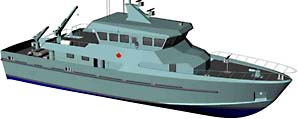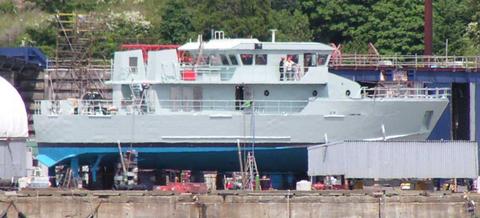NEW TRAINING VESSELS FOR THE NAVY:
THE ORCA CLASSFebruary 2006

Photo Credit: Victoria Shipyards via CASR, Simon Fraser University
On 8 November 2004, the Department of National Defence announced the awarding of a $69.7 million CAD contract to build six new training vessels for the Canadian Navy. These vessels would replace the fifty-year old, wooden-hulled, YAG 300 fleet, which had become “prohibitively expensive” to operate according to the Department.
The YAG 300 fleet, dating from the 1950s, was in desperate need of replacement due to a lack of current technology in their design and systems, improper environmental systems, poor habitability, and inadequate workspaces. To compensate for this lack in capability, the military has employed more land-based training on simulators for naval cadets; however, nothing is better to learn on than the real thing and new vessels would be required to replace the YAG 300 fleet.
The ORCA class training vessels constitute the first major Canadian Navy shipbuilding project since the completion of the KINGSTON class maritime coastal defence vessels in 1999. The vessels will allow both Regular Force and Reserve officers of the Navy to hone both bridgemanship and navigation skills. The class will allow for advanced training capabilities that closely mimic situations on major surface combatants, such as the HALIFAX Canadian Patrol Frigates. Furthermore, the integration of modern sensors, such as the Global Positioning System, in the ORCA class will permit for more effective and realistic training exercises.
The restricted crew quarters and work spaces of the YAG 300 fleet will also be a thing of the past with the introduction of the ORCA class. Instructors and crew will be housed in double cabins; students will have the relative-luxury of being berthed in cabins of four or six persons, with individual storage space provided. The extra space will allow students to comfortably be able to complete assignments, conduct briefings, and other operation-related work.
Most importantly is that the more modern ORCA class will allow the freeing of the HALIFAX frigates, and KINGSTON defence vessels, from cadet training duties. As a result, there will be less of a backlog created by the wait for one of those larger vessels to be freed up from regular duties for training. Furthermore, not having to employ large vessels like the 240-crew HALIFAX for mere cadet training duties will be highly economical to the military.
Training duties is not the only mission with which the ORCA class will be tasked. The vessels will have a higher speed than the KINGSTON class and a sufficient range to allow them to be used on coastal patrol duties when not tasked with training the Navy’s next generation of officers. The vessels will also have limited search and rescue capabilities.
January 2007 Update
While originally intended to enter into service in the middle of 2006, the first of the ORCA class was officially accepted by the Canadian Forces in mid-November 2006. The first of the class, completed in August of that year, bears the hull designation PCT 55.
Specifications – ORCA class training vessel
1. First ship will enter service in mid-2006, with the final being operational by late 2008.
2. The Canadian Government holds an option for two additional ORCA vessels (which would bring the total to 8 vessels)
3. Capable of speeds of up to 20 knots; cruising speed of 15 knots with a 750 nautical mile range (1390 kilometres).
4. The ORCA class vessel is 33 metres long, with a displacement of 210 tonnes.
5. Powered by twin 69 litre 1825kW Cat 3516 diesel engines providing thrust and three 72 kW, 4 litre Caterpillar 3054 diesel generators providing onboard electricity.

ORCA being painted at dry-dock in Victoria - June 2006. Photo Credit: Canadian Navy Yahoo Group.Sources:
Department of National Defence, Government of Canada
Victoria Shipyards Company Ltd.
Canadian American Strategic Review, Simon Fraser University
